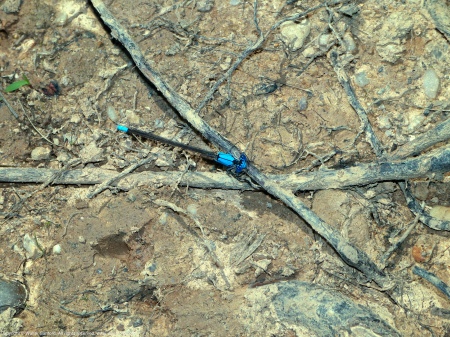
14 JUN 2016 | JMAWR | Blue-fronted Dancer (male)
These two photos show one of many Blue-fronted Dancer damselflies (Argia apicalis) spotted during a photowalk around Mulligan Pond, Jackson Miles Abbott Wetland Refuge (JMAWR). This individual is a male, as indicated by his coloration and terminal appendages.

14 JUN 2016 | JMAWR | Blue-fronted Dancer (male)
The taxonomic classification of Blue-fronted Dancer is as follows: Order Odonata (Dragonflies and Damselflies); Suborder Zygoptera (Damselflies); Family Coenagrionidae (Narrow-winged Damselflies); Genus Argia (Dancers); Species apicalis.
Related Resources: High-resolution digital scans created by Gayle and Jeanelle Strickland.
- A. apicalis male #1 (Blue-fronted Dancer) | full-size JPG
- A. apicalis male #2 (Blue-fronted Dancer) | full-size JPG
- A. apicalis female #1 (Blue-fronted Dancer) | full-size JPG
- A. apicalis female #2 (Blue-fronted Dancer) | full-size JPG
Copyright © 2016 Walter Sanford. All rights reserved.
Tags: Argia apicalis, Blue-fronted Dancer damselfly, Family Coenagrionidae, Jackson Miles Abbott Wetland Refuge, male, Mulligan Pond, Narrow-winged Damselflies, terminal appendages, wildlife photography
November 21, 2016 at 8:04 am |
Cool damselfly, Walter. I am pretty sure that almost all of the dancers that I have ever seen have been variable.
November 21, 2016 at 9:49 am |
Are you sure? Blue-tipped Dancers are common along Dogue Creek. Anyway, look for Blue-fronted Dancer next June at JMAWR — they’re easy to find!
November 21, 2016 at 6:52 pm |
It’s also possible that I have a short memory. 🙂 I did check my blog and found only a single posting with Blue-tipped Dancers and it was not from Huntley Meadows Park.
January 18, 2017 at 4:06 am |
[…] males; heteromorph females are brown. Andromorph females tend to be a lighter shade of blue than males of the same species, and do not feature the same blue coloration as males on abdominal segments eight, nine, and 10 […]
March 22, 2019 at 4:02 am |
[…] Female Blue-fronted Dancers are polymorphic: andromorph females are blue like males; heteromorph females are brown-green. Andromorph females tend to be a lighter shade of blue than males of the same species. […]